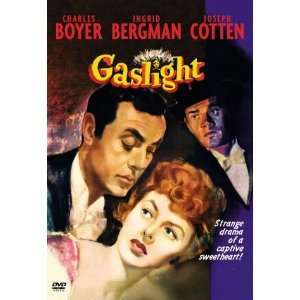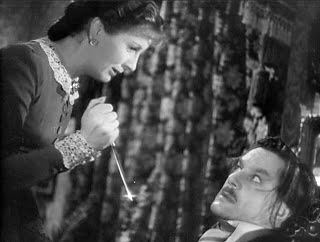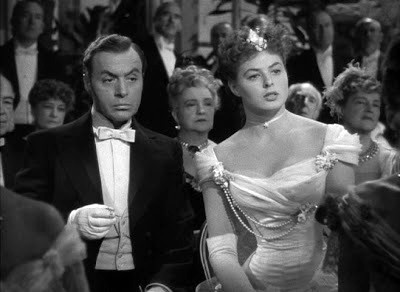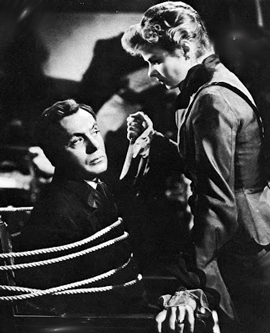| Release List | Reviews | Price Search | Shop | Newsletter | Forum | DVD Giveaways | Blu-Ray/ HD DVD | Advertise |
| Reviews & Columns |
|
Reviews DVD TV on DVD Blu-ray International DVDs Theatrical Reviews by Studio Video Games Features Collector Series DVDs Easter Egg Database Interviews DVD Talk TV DVD Talk Radio Feature Articles Columns Anime Talk DVD Savant HD Talk Horror DVDs Silent DVD
|
DVD Talk Forum |
|
|
| Resources |
|
DVD Price Search Customer Service #'s RCE Info Links |
|
Columns
|
 |
Gaslight |

|
1940 & 1944 versions double bill Warner Home Entertainment B&W 1:37 flat full frame Street Date February 3, 2004 19.98
|
Patrick Hamilton's play Angel Street was given two very good filmic translations in the 1940s. The most famous is obviously the Ingrid Bergman remake with its top star cast and ritzy direction from George Cukor. But the original English film has a lot going for it as well. Minus the star power, it is probably the better all-round thriller.
This DVD treats this unsung first version as an added extra, as it did with the earlier Mystery of the Wax Museum on the House of Wax disc last year. Add in last month's double bill of two versions of Dr. Jekyll and Mr. Hyde, and Warners is presenting us with some fascinating opportunities to compare Hollywood remakes.
|
1940 / 84 min. / Strange Case of Murder, Angel Street Starring Anton Walbrook, Diana Wynyard, Frank Pettingell, Cathleen Cordell, Robert Newton Cinematography Bernard Knowles Film Editor Sidney Cole Original Music Richard Addinsell Written by A.R. Rawlinson, Bridget Boland from the play Angel Street by Patrick Hamilton Produced by John Corfield Directed by Thorold Dickinson |
1944 / 114 min. / Murder in Thornton Square Starring Charles Boyer, Ingrid Bergman, Joseph Cotten, Dame May Whitty, Angela Lansbury Cinematography Joseph Ruttenberg Art Direction Cedric Gibbons Film Editor Ralph E. Winters Original Music Bronislau Kaper Written by John Van Druten, Walter Reisch, John L. Balderston from the play Angel Street by Patrick Hamilton Produced by Arthur Hornblow Jr. Directed by George Cukor |
1940 The Thorold Dickinson original version of Gaslight is a period melodrama with an interesting take on psychology, before the '40s Freudian fad hit Hollywood. Aristocratic Paul Mallen (Anton Walbrook) browbeats and tricks his wife until she believes she must be going insane, a process that's more than credible considering the view of marriage in Victorian times. Bella Mallen (Diana Wynyard) has brought the money into the union but is completely at the mercy of male authority. Paul imposes humiliating punishments as if she had no rights whatsoever. His views prevail in every situation and make her a virtual prisoner. In short, the Victorian husband has the right to decide what is real and what is not, giving Paul the ability to inflict extreme mental abuse.

This well-received English version of Gaslight must have been though of as an heir to the Alfred Hitchcock throne of thrillerdom. Hitchcock had recently been enticed to America by David O. Selznick and was laboring at making a different kind of Gothic romance/ghost story, Rebecca. In his absence Carol Reed thrilled the Brits with the exciting Night Train to Munich, which had a strong resemblance to The 39 Steps and The Lady Vanishes. This Gaslight begins with an old lady strangled in brutal close-up, and parallels the story inside the Mallen household with the improvised investigation of a retired detective, now a stable master (Frank Pettingell). Poor Mrs. Mallen goes nuts, or at least thinks she is, while haunted by eerie phenomena such as strange noises and the dimming of the gaslight in her bedroom. She's a damsel in distress trapped in her own household, a situation any wife can identify with. Dickinson's Gaslight is a good example of an always-popular subgenre of thriller that Hitchcock himself returned to on occasion, as in Under Capricorn, also with Ingrid Bergman.
This early version probably hews close to the original play, taking place almost exclusively around a London square of upper-class homes. There's the fancy piano recital scene interrupted by Bella's breakdown when she's accused of stealing her husband's watch. A trip to a music hall with a lively Can-Can dance is a smart break from the Gothic claustrophobia.
Diana Wynyard was well known from Rasputin and the Empress and Cavalcade. Her Bella Mallen just wants to be a happy housewife, she's shown being kind to some neighborhood kids, perhaps indicating a frustrated desire to have children. She's instead made the pawn in a sick game that causes her enough believable anxiety to provoke a real nervous breakdown. Bella is written straight to the one issue of male dominance, and is never overplayed.

Anton Walbrook (The Life and Death of Colonel Blimp, The Red Shoes) is superb as the manipulative psychopath Paul Mallen. He's more a straight Dr. Crippen-Bluebeard type than a romantic ideal, carefully working out an unlikely but somehow credible scheme. We're not asked to have much sympathy for him. Suave and sinister, Walbrook's playing is much smoother than Charles Boyer's in the remake.
Mallen tries to carry on an affair with his own parlor maid Nancy (Cathleen Cordell, much later of M*A*S*H and The Return of the Living Dead), a subplot that shows how easy it is for a Victorian householder to have his cake and eat it too, by making sure the servants don't talk to his wife. Nancy is proud of her many gentleman friends and all too eager to 'meet' with her employer, and again there's no softening of the implications. We see three abuses of male authority here: a wife driven mad, adulterous exploitation, and outright murder for profit.
Hitchcock watched his competitors like a hawk and may have been influenced by Dickinson's film. When Bella steps out onto her balcony at the end, 'cured' but disillusioned, she's an isolated soul facing an uncertain future. Visually, the moment is similar to the end of Vertigo, a tale in which romance is a weapon to manipulate a man into a nervous breakdown.
1944 The English original has been almost forgotten in the years since the success of the Cukor/Boyer/Bergman version of Gaslight. This 1944 Hollywood rethinking does a superficial rewrite that makes telling changes in the story and the characters. Accommodating two of the most romantic actors of the time can account for much of this, but the rest seems to stem from a desire to soften and 'ritz up' the original. Although he only provided the services of two of the actors, talent raider David O. Selznick may have influenced the direction of the story as well; his credit is jammed into the cast list right behind the stars.
The changes for this 1944 remake are a mixed bag. Some fit and others don't. The culture quotient is raised to glamorize the swooningly attractive Ingrid Bergman. The heroine is now related by blood to the murder victim, and the victim is changed into a grand dame of the musical theater. Thus Bergman (now renamed Paula Alquist) returns home after a childhood spent in Italy. She doesn't suspect her new husband Gregory (Charles Boyer) thanks to a 'discreet' Scotland Yard cover-up. The unaccounted-for jewels that motivated the murder were hushed up because a royal personage was involved (shades of various Jack the Ripper theories).

So the movie skips the gruesome murder and instead treats us to a drawn-out romantic opening in Italy. The situation in London is given a glamour makeover as well. The ordinary-Joe neighborhood snoop detective is jettisoned, and his function divided between two new characters. The detective is now a handsome fellow played by Joseph Cotten. He casually re-opens the case and conveniently becomes the likely romantic savior of our heroine (not to mention another contractee paycheck for David O.). Cotten disobeys his stuffy superiors and proceeds on his own. In keeping with the MGM gloss treatment, he's pointedly established as a gentleman aristocrat himself, one of those detectives who has a valet and gets invited to swanky recitals. As it turns out, Cotten's detective also has an interest in the original case, as he was a boyhood fan of the murdered aunt. So he's both Prince Charming and Sherlock Holmes tied up in a handsome package.
The second half of the detective character is provided by Dame May Whitty as a spirited neighborhood snoop. Whitty reinforces the notion that this is supposed to be England, but is mostly there for lighthearted punctuation. She's so obviously a borrowing from Hitchcock's The Lady Vanishes that we can't help but think that Alfred had a hand in the stew -- perhaps Selznick was at some point pushing for Hitch as the director, so as to collect yet another paycheck. The cute Whitty is certainly not unwelcome, but she musses up the clean lines of the story.
As personified by the saucy, insolent Angela Lansbury (in her first role at age 16) the maid Nancy patronizes Paula and flirts with Gregory, but nothing ever comes of it. There's no excursion to the music hall, saving Louis B. Mayer an expensive scene. The adultery aspect of the story doesn't seem as important this time around, even though Lansbury makes a solid impression.
The remake plays as a good mystery that spotlights isolated star turns. Lansbury, Boyer and Bergman each get big solo moments, either by themselves or with the other actors merely looking on. Gregory's villainy is so obvious we have to think that Paula is a much more male-dependent simp than Wynyard's Bella; he's so cruel that the screenwriters wisely make the cook (Barbara Everest) change loyalties before the conclusion. Boyer undergoes a sudden lapse into mania while talking about the real love of his life, fine gems. It doesn't mesh with the character's previous self-control, and comes off as just too thick.
1Bergman is far too compelling not to be good, but we can see the mental gears turning when the script sets her up for her big moments. The famous turnabout scene has a phony dramatic crescendo written-in to give her a supreme Acting! bit that isn't as well motivated as it was in the first film --"What knife?"
2 (spoiler)
(spoiler)
Interestingly, both versions emphasize that the murderous husband is already married to a woman far away, handily absolving wife number two from any guilt for dropping a dime on Hubby. Just the same, I think Bella/Paula would most likely wind up in precarious social straits. Stiff Victorians would still consider her a 'used woman.' The fact that she is a completely innocent victim would be beside the point.
(spoilers)Both films are good, but the English show gets my vote. It's less predictable and stresses the thriller aspects, allowing the two lead performances to shine from within (and I saw the remake first, several times over the years). The Cukor version is a star vehicle first and foremost and reeks of commercial calculation. With those added scenes up front it's also overlong -- it was common for local TV stations in the 1960s to just lop the first reel off this show, starting broadcasts in London. The first version is a nice rumination on the Victorian thriller, and its heroine makes a journey to truth and freedom. In the Cukor version, a shook-up Bergman hops predictably from bad husband Boyer to the waiting arms of dreamboat admirer Cotten. When placed next to the English show, it seems more contrived and has less to say. But Bergman is a magnificent compensation.
Hidden in the cast somewhere is Gibson Gowland, of 1925 Greed fame. Young Terry Moore, billed as Judy Ford, plays the young Paula for one brief shot in an opening flashback.
Warners' Gaslight DVD double bill looks very good indeed. Both shows are in excellent shape, with a few hairline scratches here and there. Grain is minimized in both. The English version appears to be an American source with a Leo logo spliced on.
The movies occupy opposite sides of a flipper disc. The 1940 version is over half an hour shorter and for that reason is given the extras. The trailer for the 1944 remake is welcome, and a short docu gives us some remembrances by Angela Lansbury. She has a fine time telling us about her big break, the generosity of her co-stars and her lack of experience as a beginner. The featurette doesn't mention anything about the original version, but is satisfying just the same.
A brief newsreel features a staged shot of a very awkward Jennifer Jones presenting Ingrid Bergman with an award.
On a scale of Excellent, Good, Fair, and Poor,
Gaslight 1940 and
Gaslight 1944 rate:
Movies: both Excellent
Video: both Very Good
Sound: Both Very Good
Supplements: Reflections on Gaslight new documentary, archival newsreel,
1944 trailer
Packaging: Snapper case
Reviewed: January 26, 2004
Footnotes:
1. It also seems a pale echo of several impassioned scenes that Boyer brought to life in earlier films like Hold Back the Dawn and Garden of Allah.
Return
2. In fact, the entire organization of the access to the attic room and the villain's capture are much more exciting in the 1940 film. In Cukor's version, the attic is 'boarded off' -- by a flimsy set of boards that hinge and latch like a door, serving no purpose whatsoever!
Return
Review Staff | About DVD Talk | Newsletter Subscribe | Join DVD Talk Forum
Copyright © DVDTalk.com All rights reserved | Privacy Policy | Terms of Use
|
| Release List | Reviews | Price Search | Shop | SUBSCRIBE | Forum | DVD Giveaways | Blu-Ray/ HD DVD | Advertise |





